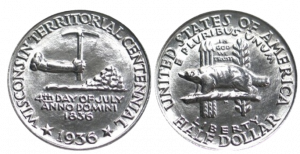The 1936 Wisconsin Territorial Centennial Half Dollar
Posted onIn 1936 the Wisconsin Centennial Commission appointed a Coinage Committee to pursue the development and minting of a commemorative coin to celebrate and help finance the Wisconsin Centennial that year.
The Wisconsin Centennial half dollar came at a time when the commemorative coin market was booming. This surge was due to previous commemorative coins that were minted in low quantities causing them to appreciate in value significantly. Many of these pieces sold at a premium to their earlier prices.
By the end of March of 1936 the Senate passed the bill paving the way for the half dollars. From there, the bill moved on to the House of Representatives where an amendment was requested which would increase the authorized minting to 25,000.
The job of designing the coins fell to David Parsons, a local art student. The only stipulations he was given was that the seal of Wisconsin Territory had to appear on one side, and a badger had to be on the other. However, his designs were deemed unsuitable mostly due to the light relief that did not adequately show the detail of the art. After the Bureau of the Mint rejected his work, the Wisconsin Centennial Commission tasked New York sculptor Benjamin Hawkins with the job of designing the coins. After being given a three week deadline, Hawkins submitted his designs which the Commission of Fine Arts approved almost immediately.
The image on the obverse, a miners arm gripping a pickaxe, meant to represent the mining activities that drew so many to southeast Wisconsin in the 1820s. In fact, a lead mining boom started in the late 1820s. The metal was so important at the time that many called it “gray gold.”
The badger on the reverse was selected because it is the state animal. This choice also reflects the fur-trading business that characterized the area at the time. The three arrows behind it illustrated the conflict between early settlers and the Black Hawk Indians. The olive branch next to the arrows is meant to symbolize the peace that followed. However, some contend that this “peace” was nothing more than the forceful expulsion of Indians from their land. The “H” appearing below the badger marks the work as Hawkins’.
The Philadelphia Mint struck the coins and made them available to collectors via mail order at a cost of $1.50 per coin. The composition of the coin, 90% silver, 10% copper, made it more valuable than the face value of $0.50. Organizers marketed the coin at the Centennial Cavalcade of Wisconsin in late July of 1936. The complete minting was sold by the1950s.
Today the images on the coin recall the early days of Wisconsin before its admission to the Union in 1848. Prior to this, the Wisconsin Territory had been part of the Northwest Territory before the British gave up the region amid the Treaty of Paris. The coin is a reminder of the hard-won land that became, and remains, such a part of America’s identity.
Want to read more? Subscribe to the Blanchard Newsletter and get our tales from the vault, our favorite stories from around the world, and the latest tangible assets news delivered to your inbox weekly.







